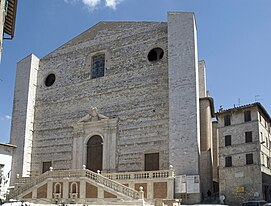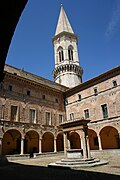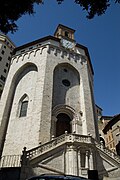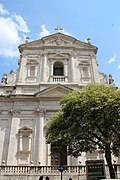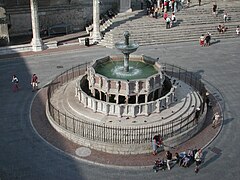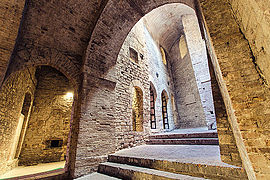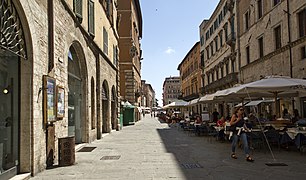Perugia
| Perugia | ||
|---|---|---|

|
|
|
| Country | Italy | |
| region | Umbria | |
| province | Perugia (PG) | |
| Coordinates | 43 ° 7 ' N , 12 ° 23' E | |
| height | 493 m slm | |
| surface | 449 km² | |
| Residents | 166,969 (Dec. 31, 2019) | |
| Population density | 372 inhabitants / km² | |
| Post Code | 06121-06135 | |
| prefix | 075 | |
| ISTAT number | 054039 | |
| Popular name | Perugini | |
| Patron saint | St. Lawrence and St. Constantius , first bishop of Perugia | |
| Website | Perugia | |
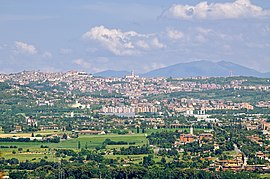 Panorama of Perugia |
||
Perugia [ pe'ruːd͡ʒa , ] is the capital of the region of Umbria in Italy and the province of Perugia . It has 166,969 inhabitants (as of December 31, 2019).
history
Antiquity
Archaeological finds show that the area of today's Perugia, whose ancient Latin name was Perusia, was already at the time of the early Iron Age Villanova culture in the 9th and 8th centuries BC. Was settled. Since the 2nd half of the 6th century BC It seems to have undergone continuous development. According to the ancient legend, either Achaeans or the Etruscan Aulestes founded the city, but according to archaeological research, a Greek foundation is out of the question. The town, located on a prominent hill (493 m) above the plain, is believed to have originally been a settlement of the Umbrians and has only been known since the 5th century BC. A specifically Etruscan character. Her Etruscan name was Perusna . It belonged to the twelve most powerful Etruscan cities and to the League of Twelve Cities . The ancient city of Arna is now an eastern district.
Perusia first appears in the ancient literary sources in 310 BC. Chr. On. Accordingly, that year the Etruscans besieged the city of Sutrium , which was allied with Rome , whereupon the Roman consul Quintus Fabius Maximus Rullianus decided, in view of the hostile superiority, to force the Etruscans by diversion to lift that siege. To this end, he marched with his army into the Central Etruria, which had been spared from war for many years, and defeated an Etruscan army not far from the settlement, so that Perusia and the cities of Cortona and Arretium had to commit to a thirty-year armistice. Nevertheless, Perusia soon took part in the Third Samnite War against Rome. After the victory of the Roman troops over the Etruscans in the Battle of Sentinum in 295 BC. An army of the Peruvians lost another battle against Fabius Rullianus, after which the city fell to the Romans. They built a 2.9 km long fortification ring around the city. But Perusia remained populous and prosperous and remained loyal to the Romans in the Second Punic War . A cohort from Perusia defended in 216 BC. BC together with praenestinians the city of Casilinum in Campania against Hannibal . Furthermore, Publius Cornelius Scipio Africanus received 205 BC. BC from Perusia wood and grain for his intended expedition to North Africa.
Apparently Perusia was after the 91-88 BC. Chr. Continuous Social War awarded Roman citizenship. It had the status of a municipality and its own senate, but probably no coinage of its own. During the Peruvian War (winter 41/40 BC ), the consul Lucius Antonius , the brother of the triumvir Marcus Antonius , who was fighting against Octavian (later Emperor Augustus), holed up there . In the city, which was closely enclosed by Octavian and his generals, such a terrible famine broke out that the Peruvian famine ( fames Perusina ) became proverbial. After the surrender of the city, Octavian pardoned Lucius Antonius and his army, but had all the councilors of Perusia executed with the exception of one. But that he had over 300 senators and knights on March 15, 40 BC. The ancient historian Jochen Bleicken believes that the ancient historian Jochen Bleicken believes that the day of Caesar's death was slaughtered at an altar that was built for the deceased . The city released for looting burned down and was almost completely destroyed. Whether the fire was started on purpose or unplanned as a result of an isolated fire - a distinguished Peruvian named Cestius Macedonicus had set fire to his house out of desperation - could not be determined. Later Augustus ordered the generous rebuilding of the city, and it was now named Augusta Perusia . The emperor also gave it a new constitution, so that since then Duumvirn have acted as senior officials in Peru. In the period that followed, the city did not regain its former glory. Under Emperor Trebonianus Gallus , who ruled from 251-253, it was given the status of a colony .
Middle Ages and Modern Times
According to the early Byzantine historian Prokop , Perusia was a strong fortress and the most important city in Etruria in the 6th century . It played an important role in the Gothic War of Emperor Justinian . In 537 it was conquered by Belisarius and given a strong garrison. In 547, the city in which Cyprianus was in command was besieged by an army of the Ostrogoth king Totila . But only after the death of Cyprianus and the recall of Belisarius from Italy the Ostrogoths were able to take Perusia at the beginning of 549. Totila then destroyed it and had St. Herculanus , bishop of the city, beheaded. After the Ostrogothic King fell in July 552, Narses recaptured Perusia for the Byzantine Empire . Later the Lombards were able to take control of the city for a short time, but the Byzantine exarch Romanus conquered them back along with Sutri and other cities during his campaign in 592 . Romanus was able to pull the Lombard Duke Maurisio, under whose command Perusia had been, to his side and had the city handed over from him. The Lombard king Agilulf then left Pavia with his army in 593 , crossed the Apennines , besieged Maurisio for a few days in Perusia, took the city and had the apostate duke beheaded. Soon after, however, Perusia fell back into the hands of the Byzantines.
In medieval and early modern Italian, the city could be called Perugia , but also - in pronunciation and phonetic variants - as Perogia, Perusa or Perosa . In the Middle Ages, the city was a loyal ally of Rome against the emperor . In 1198, Perugia officially broke away from imperial authority by placing itself under the protection of Pope Innocent III. posed. It was ruled by Guelfs merchants who made it the only important Umbrian trading center, similar to the Tuscan city-states. The climax of this development was in the 13th century.
The Guelfean orientation of the city did not mean, however, that there were no difficulties with the supposedly protective papal state . Around 1500, at the time of the first heyday of humanistic historical research, historians calculated z. B. Perugia to the Tuscan cities, as emerges from the Chronicle of Matarazzo . As early as 1354, at the time of Cardinal Albornoz , Spoleto was finally incorporated into the Papal States, Foligno followed in 1439, Orvieto in 1450 , and at the beginning of the 16th century the other cities of Umbria followed the same route, most recently Perugia in 1540.
In 1473 the holy ring , the alleged engagement ring of Mary , was stolen from Chiusi and brought to Perugia, giving the city a considerable increase in prestige and income. There were clashes with Chiusi and Siena to the brink of war. The ring is still shown and venerated in the cathedral's Josefskapelle today.
In the so-called "Salt War", the Perugins were then defeated by Pope Paul III in 1540 . They had refused to accept a new salt tax and the Pope acted drastically. In a very short time - from 1540 to 1543 - he had Antonio da Sangallo build a fortress on the Colle Landone in order to keep the city under control , which is named Rocca Paolina after its builder . For more than three centuries, Perugia remained subject to the papal state. Spiritual life froze in the academies .
The rule of the church was interrupted twice: in 1798/99 after the invasion of French troops and 1809–1814, after a decade of church restoration, as part of the Napoleonic Empire. The uprisings of 1831, 1848 and 1859 ( Perugia bloodbath ) were put down by papal troops. On September 14, 1860, Piedmontese troops marched into Perugia. Umbria was incorporated into the new Italian state.
A few years ago those parts of the city that had been buried after the Pope's victory were exposed again and today form a somewhat eerie town on the mountainside below the upper, "official" town, in which escalators, shops and the like are housed as with subway systems.
Culture and sights
In addition to the rather uninteresting new building areas on the plain, the old town on the mountain offers many narrow streets with flair and numerous interesting museums and cultural monuments:
Museums
- The Galleria Nazionale dell'Umbria (National Gallery of Umbria) art museum with works from the 13th to 15th centuries, including works by Arnolfo di Cambio , Piero della Francesca , Perugino , Pinturicchio
- The Museo archeologico nazionale dell'Umbria ( National Archaeological Museum of Umbria ) in the former convent at the Basilica di San Domenico . It is one of the most important Italian archaeological museums.
- In the Collegio del Cambio you can see frescoes by Pietro Vannucci, known as Perugino
Churches
- The cathedral of Perugia , 14th-15th century
- The Tempio di San Michele Arcangelo , a round church from the 5th / 6th centuries. century
- San Domenico from the 14th to 17th centuries
- San Pietro from around 1600
- Oratorio San Berhardino , from 1451
- San Bevignate, a church belonging to the Knights Templar
- San Francesco al Prato
- San Ercolano
- San Filippo Neri
Profane structures
- Palazzo dei Priori with its remarkable external staircase
- The medieval Fontana Maggiore , which the Peruginians consider the most beautiful fountain in the world
- The Arco Etrusco , an arch structure from the 3rd century BC. That because of the inscription AD. AVGVSTA PERVSIA and Arch of Augustus is called
- The underground district under the Rocca Paolina, which was built after the subjugation of Perugia by Pope Paul III. Was buried under the Rocca in 1540.
- The Corso Vannucci with its shops and cafes in the center of the old town
- The university for foreigners (L'Università per stranieri) founded in 1925 in the Palazzo Gallenga Stuart
Regular events
- Umbria Jazz : Perugia is also the venue for Umbria Jazz, one of the largest and most famous jazz festivals in the world. The ten-day festival has been held annually at the beginning of July since 1973.
- Eurochocolate , one of the most popular European chocolate events, takes place every October.
Specialties
The Baci Perugina (kisses from Perugia), pralines filled with nougat and whole hazelnuts, are known throughout Italy - and beyond . the manufacturing company Perugina is based in Perugia and is part of the Nestlé group.
education
In addition to the University of Perugia , Perugia is also home to the University of Perugia for foreigners , where foreign students from all over the world come together to study the Italian language and national culture. The lecture rooms are housed in Palazzo Gallenga , the only baroque palace in the city.
The Biblioteca della Deputazione di storia patria per l'Umbria has existed since the end of the 19th century .
Sports
- The football club AC Perugia Calcio currently plays in the second-rate Lega Nazionale Professionisti Serie B .
- The team of Perugia Calcio a 5 was the 2005 Italian champions in indoor football ( futsal ).
- The volleyball men from Sir Safety Perugia play in Serie A1, the highest Italian league.
traffic
Perugia has implemented very rigid measures against car traffic. A special permit is required at certain times of the day in order to drive into the city center by car, which has a positive effect on the mobility of pedestrians within the historic old town. Cars can be parked in one of the large parking lots in the lower parts of the city and the city center can be reached from there via escalators through the Rocca Paolina .
Since 2008 the Minimetrò Perugia has also been connecting the lower parts of the city with the old town with seven stations.
Perugia Airport is twelve kilometers east of the city .
Twin cities
Sister cities of Perugia are
|
Personalities
Famous personalities of the city are included in the list of personalities of the city of Perugia .
literature
- Danilo Nati: Le necropoli di Perugia (= Auleste [Città di Castello]. 3, 1). Volume 1. Edimond, Città di Castello 2008, ISBN 978-88-500-0372-3 .
Web links
Individual evidence
- ↑ Statistiche demografiche ISTAT. Monthly population statistics of the Istituto Nazionale di Statistica , as of December 31 of 2019.
- ↑ U. Ciotti: PERUSIA (Perugia) Umbria, Italy . In: Richard Stillwell et al. a. (Ed.): The Princeton Encyclopedia of Classical Sites. Princeton University Press, Princeton NJ 1976, ISBN 0-691-03542-3 .
- ↑ Justinus , Epitoma historiarum Philippicarum Pompei Trogi 20, 1, 11.
- ^ Maurus Servius Honoratus , Commentary on Virgil , Aeneis 10, 198.
- ↑ a b Luisa Banti : Perusia. In: Paulys Realencyclopadie der classischen Antiquity Science (RE). Volume XIX, 1, Stuttgart 1937, Sp. 1068-1085, here: 1082.
- ↑ Titus Livius , Ab urbe condita 9, 37, 12; Stephanos of Byzantium , Ethnika, s. Perraision .
- ↑ Diodor , Bibliothḗkē historikḗ 20, 35; Titus Livius, Ab urbe condita 9, 37.
- ↑ Titus Livius, Ab urbe condita 10, 31,3.
- ^ Titus Livius, Ab urbe condita 23, 17, 11.
- ^ Titus Livius, Ab urbe condita 28, 45, 18.
- ↑ a b Luisa Banti: Perusia. In: Paulys Realencyclopadie der classischen Antiquity Science (RE). Volume XIX, 1, Stuttgart 1937, Sp. 1068-1085, here: 1083.
- ↑ Appian , Civil Wars 5, 31-49; Cassius Dio , Roman History 48, 14; on this Jochen Bleicken: Augustus. A biography. Fest, Berlin 1998, ISBN 3-8286-0027-1 , pp. 189-193.
- ^ Prokop, Gotenkrieg 2, 16 f .; 3, 6; 3, 25; 3, 35; 4, 33.
- ^ Paulus Diaconus , Historia Langobardorum 4, 8; to Ludo Moritz Hartmann : History of Italy in the Middle Ages. Volume 2, part 1. 1900, p. 105 ( Scan - Internet Archive ).
- ↑ Carl Joseph Bouginé (ed.): Handbook of the general Litterargeschichte after Heumann's plan. Volume 1. Zurich 1789; Reprint: Forgotten Books, [o. O.] 2017, ISBN 978-0-243-54559-9 , p. 497.
- ↑ Johannes Weinand: Leo XIII. His time, his pontificate and his successes. Bachem, Cologne 1886; Reprint: Salzwasser-Verlag, Paderborn 2012, ISBN 978-3-8460-1001-3 , p. 106.
- ↑ Corrado Augias : The Secrets of the Vatican. Beck, Munich 2011, ISBN 978-3-406-61363-0 , p. 58.
- ↑ Harald Keller : The art landscapes of Italy. 1960; ([2nd] new edition :) 1st edition. 2 volumes, volume 1. Insel-Verlag, Frankfurt a. M. 1983, ISBN 3-458-32327-9 , p. 390.
- ↑ Twin cities. In: perugia.it, Città di Perugia, accessed on June 12, 2019.






